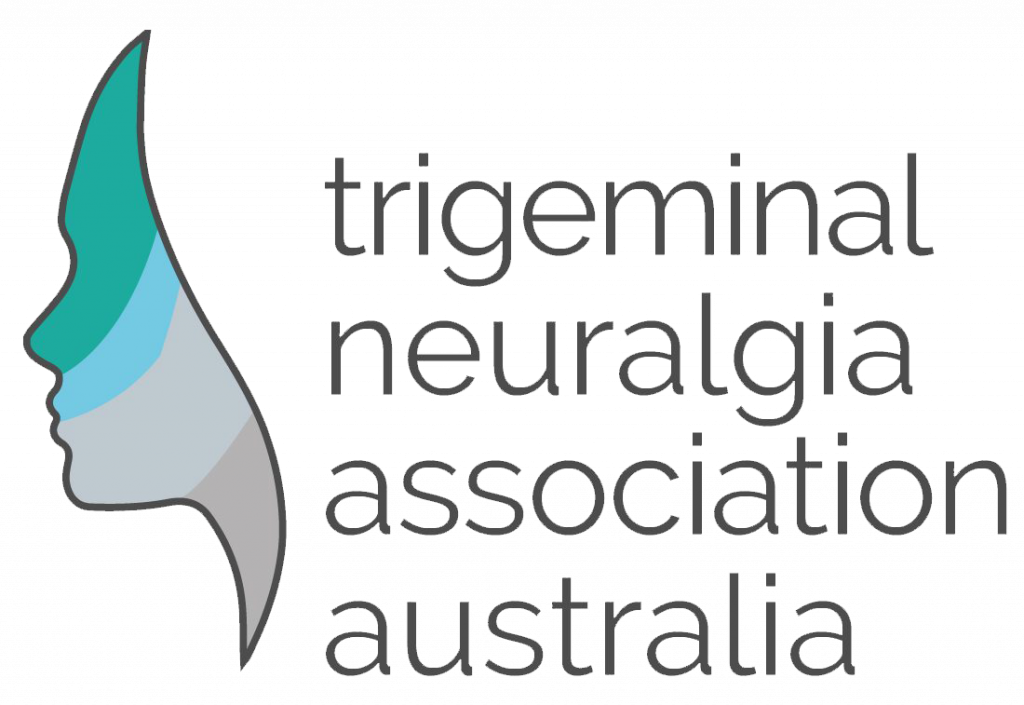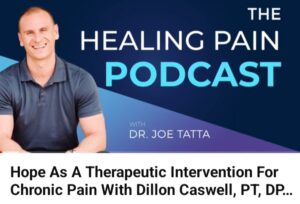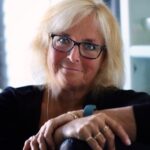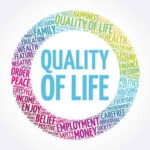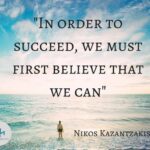The following podcast continues to explore how meaningful activity and hope plays an important role in chronic pain management.
Further reading on the subject of HOPE
Hope As A Therapeutic Intervention For Chronic Pain With Dillon Caswell, PT, DPT, SCS
Welcome back to the Healing Pain Podcast with Dillon Caswell, PT, DPT, SCS
The more we study pain and pain management, the more we realize how much power the person experiencing the pain has over their own experience and healing. This is why our job as practitioners is not to be the solution for our patients, but to help them find the solution for themselves. This powerful perspective is brought to us by Dillon Caswell, PT, DPT, SCS, a groundbreaking expert on using hope as a therapeutic intervention for chronic pain. In this episode, we learn how hope can easily be one of the most effective salves to pain that we have access to. This is not the passive yearning that we often associate with the word “hope”. This is something much more powerful, and it may be the thing that makes a difference in your practice or in your life. Tune in to learn more!
Watch the episode here
Listen to the podcast here
TRANSCRIPT – Hope As A Therapeutic Intervention For Chronic Pain With Dillon Caswell, PT, DPT, SCS
In this episode, we’re discussing hope, widely considered as an important therapeutic factor in health, and the usefulness of hope as a therapeutic intervention, not only for chronic pain but also for many other chronic health conditions. We’re joined by Dr. Dillon Caswell. Dillon is a sought-after doctoral-trained physical therapist with over a decade of experience in practice as well as higher education as an adjunct professor at SUNY Upstate Medical University.
Dillon is on a mission to cut through the misleading narratives that surround the human experience of healing while unearthing the science that supports this process. Dillon is host of one of the world’s leading health podcasts called the Prehab Podcast as well as the author of a new book called, Hope Not Nope: Using Hope For Healing and Reclaiming Identity as a Lifelong Athlete in a Sick Healthcare System.
In this episode, we dive headfirst into the depressing challenges society faces when it comes to pain and the process of healing. We’ll also explore the heart-wrenching question of why people give up on meaningful activities and how we can infuse hope into a healthcare system that sometimes feels like it’s drowning in despair. Dillon’s work also begins to unravel the incredible power of the human brain and how a shift in our mindset can be the key to unlocking relief for those suffering from chronic pain.
Thank you for joining us as we embark on this transformative journey of discovering the role that hope plays in chronic pain recovery. Don’t forget to hit that subscribe button and make sure to share this episode with your friends and family. Without further ado, let’s begin and let’s meet Dr. Dillon Caswell.
—
Dillon, welcome. It’s great to have you on.
Joe, thanks for having me on. I’m excited to dive into this conversation.
Me too. We dance around this topic a lot, but we don’t ever talk directly to it or raise awareness around it the way you’re doing with some of the work you’re leading. I think we’re going to talk about some of the work you do as a licensed physical therapist and a practitioner and then raise awareness around this topic. Why is the topic of hope something that we should be talking about in chronic pain and chronic illness in healthcare in general?
It’s a great way to start it off and dive into it. There are a lot of misconceptions about the term hope. A lot of people will think that hope means that it’s something passive. You’re sitting there and hoping that something gets better. You’re hoping that you get out of chronic pain and get back to these activities. When we look at hope, there’s a famous researcher out of Kansas University named C.R. Schneider. He was a hope researcher and found that for hope to exist, it’s an interplay of the following three statements of self-agency, goal-directed behavior, and a framework.
When we look at that, we start to understand why hope is so important to be integrated into our healing process. Much of what we’re getting from our current healthcare system speaking to the United States is, “Nope, you go in, you’re in pain, and you’re uncertain.” You don’t know what’s going on. You want to know, “Am I going to be okay? Am I going to be able to work? Am I going to be able to provide for my family? Am I going to be able to play this sport? Am I going to be able to go for the morning run?”
All these things that make you the person that you are, you’re starting to wonder, “Am I going to be able to do these things because I’m uncertain? My movement system seems pretty chaotic right now. I’m having this pain response and may not know what’s creating it. I then go into an office. Instead of getting a solution, I’m being told or given more evidence that I’m frail and fragile.” It could be through imaging or by not being heard. There’s research showing that a person is interrupted every eleven seconds in an office when they’re trying to tell their story.
I go back and think of growing up, having an Italian family, and how frustrating it is to attempt to tell a story and then continuously get interrupted. You get to the point where you’re like, “I’m not going to tell the story anymore. I’m checked out of this because I want to move on to the next thing.” Many people are having this experience when they’re looking for some certainty, answers, or a solution. They’re getting further rejected. They then start to give up things that are meaningful because they’re afraid to live the life that they’re meant to live.
I commonly say that we have so many people in this world, but not a lot of people are alive. A lot of people are getting up and putting their effort into getting through that day. Granted, we all have those days you’re struggling to get through. Overall, we need more people who are alive, enthusiastic, and happy to be doing the things that they were meant to do. To me, that’s where hope comes in. We need self-agency. We need to recognize that we can take ownership of our actions. There’s this common thought that we have this lizard brain that controls us. This lizard brain makes us do certain things.
We have so many people in this world but not a lot of them are alive. We need more people who are alive, who are enthusiastic, who are happy to be doing the things they were meant to do. That’s where hope comes in.CLICK TO TWEETLearning from Dr. Lisa Feldman Barrett, one of the top neuroscientists in the world, we learned that we have the ability to respond versus react to situations. We can create self-generated actions to start to take control of whatever experience we’re going through. A lot of people will sit back and be delivered the note and go, “Whatever. That’s what was supposed to happen. I’m not supposed to move forward with this.” There’s a whole other side to this story that we’re hoping to give through this message of hope not nope.
We talk a lot about active ways to cope with pain and other conditions. There are passive ways to cope. It sounds like what you’re saying is that hope is an active means of coping with whatever condition, situation, and poor health that someone is facing. Initially, when people think of hope, it’s almost like you hear the expression, “Tonight, I’m going to hope and pray on this.” Some people view that as taking a more passive or backseat approach to what they’re dealing with.” However, you’re trying to say, “Hope is a positive psychological way to cope with whatever it is that you’re facing.”
It’s using these self-generated actions, goal-directed behavior, and a framework to achieve it. One of my favorite sayings is that hope is learned and earned, meaning we learn to become hopeful when we face adversity and suffering. If you’re living, you’re going to face adversity and suffering as part of the human experience. One of the things that we can guarantee in this life is that there are suffering and obstacles that you’re going to face.
As you go through those and adapt and become more resilient, you start to learn that you can remain hopeful in these situations. It didn’t happen by you passively letting these things happen to you. They happen because you decided to lean into it and that there was going to be a different outcome that was going to happen from that obstacle. People think of hope as being this passive, “I’m going to hope that it gets better.” Hope is learned and then it’s earned. How is it earned? It’s earned from putting the work in and by taking actionable steps to get closer to that outcome.
Of course, this is all wrapped up in the thought of, “How do we help people heal?” I say, “How do we help people?” What you’re saying is that, in some way, our job as a practitioner, or maybe your job as a friend or a colleague, is to empower someone to heal. What are some of the challenges you see with regard to the way we approach, on this show, chronic pain, but in general, the healing of chronic illness and disease in our Western society and medicine?
It’s partly why I wrote the book Hope Not Nope to hopefully become part of the solution. I spent so much time becoming angry and complaining about the healthcare system. I said earlier that we all will face suffering, but my belief is that our suffering has been conditioned to be longer than it was meant to be because of the narrative surrounding these chronic illnesses and the lack of control.
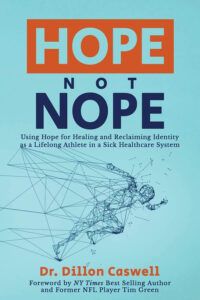
When we look at the number of chronic diseases, it’s pretty scary. The rates of type 2 diabetes are increasing. Seeing this number increase, but people are not getting the message, “There are a lot of lifestyle habits that you can use that this thing can be preventable.” Type 1 diabetes is a completely different story, but in type 2, we have a good chance to get rid of that when we look at the current treatments that are offered for chronic pain.
Joe, I know you’ve done a lot of work in this area, but at least in the United States, people are often offered opioids as a first-line defense to taking care of their chronic pain. We know that that’s not the solution. In Upstate New York, we’ve gotten a ton of pollen. There hasn’t been a lot of rainfall, so there’s been all this pollen all over the place. I have a studio, and in front of the studio, there was this layer of pollen coating the driveway.
I spent about three weeks sweeping out the garage because of all the pollen that was in there. I kept sweeping it out to the driveway. The next day, I’d go in, pop the door open, and the pollen would come back in. I kept doing this over and over again until I had the realization that I needed to take the next step. The next step is to sweep the pollen out of the studio. Now, I need to get it out of the driveway, or else it’s going to keep blowing back in again.
When we look at chronic disease, that’s what the model is right now. It’s taking the pollen and sweeping it back into the driveway, but it’s not taking care of what’s causing that underlying condition. We offer these short-term fixes. What ends up happening is that the person then gets in the cycle that it keeps coming back because what has likely created it hasn’t been dealt with front on. It’s just been distracted.
To me, the challenge is how we get our system to start taking that second step. How do we get people to start going, “I’m going to go ahead and decline that opioid because I want a different approach that’s going to take the pollen and get it out of the driveway?” Once that’s out of the driveway, and back to that analogy, now I’m not spending my morning sweeping for an hour. I’m not spending my evening sweeping for an hour. I’ve gifted myself two hours in the day to partake in meaningful activity because sweeping is not meaningful to me. It’s a task that I do to keep my clients happy, but it’s not something I enjoy doing.
Now, I don’t have to sweep as much. That means I have two more hours to read, research, or hop into conversations. By doing that and taking that extra step, I’ve now gifted my time to be able to do things that are more fulfilling. By doing that, as that time adds up over time, my body is going to start to heal itself because of the fulfillment that it’s feeling. Instead of doing these tasks, it’s going to be, “I’m excited to do these things.”
It’s essentially because you see people with pain as well. When we talk to people with pain in their history somewhere, at one point, they had a ritual active life, and then this pain or this condition developed, or whatever happened to someone. There is this tipping point where you can see the meaningful activities at that point started to become less important, or for some reason, got pushed to the wayside or got put on the back burner.
It’s interesting to see or start to think about, “Why do people give up their meaningful activities?” If they are meaningful and bring you a sense of joy and fulfillment and you see a lot of value in what’s being done, what does lead to that straw breaking the camel’s back of, “Now, I’m not going to focus on my meaningful activities? I’m going to focus on my pain.”
The short answer to that is fear. It’s fear of, if they were to continue that activity, what potentially could happen. It starts with the conversation of what pain is because pain is this experience that most of us are going to have. I used to say all of us will have it, but there is a condition and congenital insensitivity in which a person doesn’t have that output of pain. What’s interesting is that when people have that, their lifespan is shorter. Pain gives us a constraint. It lets us know our thresholds. That can be an emotional or a physical threshold. Taking a step back, we need to change our perspective on pain.
Pain is not a bad thing. Pain is a constraint. Pain is asking us to change something about our life or being. It may be our sleep habits, relationships, work, or an activity that we’re doing. Pain is a request to change something about your being. With that being said, I was researching and reading this story about Albert Einstein, which I included in the book because it got me thinking. I start by saying it was from Albert Einstein because if you hear this story, you’d be like, “That sounds witty. That was Albert Einstein. That makes sense.”
The story goes that Albert Einstein was a freshman in his college class, and his professor stated the question, “If God exists and God created everything, then did God create evil?” The class was pretty silent. Einstein raises his hand, and he goes, “I have a question for you. Does cold exist?” The professor goes, “Of course, cold exists.” Einstein goes, “No. We have heat and mega heat. We have all these different levels of heat. We have absolute zero. We can continue to measure heat as it gets hotter, but we have no measurement for cold. Cold doesn’t exist. Cold is just the absence of heat.” The professor goes, “Okay.”
Einstein keeps going, “Does darkness exist?” The professor goes, “Of course, darkness exists.” Einstein says, “No. We can measure the speed of light. We have all these different variables for light, but we are continuously looking for dark matter and can’t find it. Darkness is the absence of light.” He keeps on going on. In the story, what stuck out to me and what I started reflecting on in our work is, “Does pain exist, or is it an absence of something?” We’ve seen the definition of pain evolve. We’ve seen international societies developing more pain definitions. Basically, what it comes down to is that it’s an individualized experience that’s specific to that person and the parameters around it.
We could have the same shoulder injury, but our response to that can be completely different depending on your previous beliefs, mindset, environment, and solutions that you’ve been offered. We can have the same injury but have a completely different pain response to it. It got me thinking, “Does pain really exist?” It’s a deep-thought question. I know it’s one that when people are tuning in, they’re probably like, “What do you mean? Yeah, pain exists.” The question that I pose is, “Does it exist, or is it an absence of meaningful activity?”

The reason that I pose that is because people I’ve worked with who are in chronic pain have that tipping point in which they’ve given up their meaningful activity. I gave an example in the book about this. I’ve worked with this one lady and she was in chronic pain for years. We tried a bunch of different things, and it seemed like nothing was working. I got to the end of it where I was like, “I don’t think I have much more that I can offer.” I’m not giving up on this, but I don’t want to be wasting her time. I want to make sure that she’s seeing the right provider and getting the right things.
She mentioned to me that her lifelong childhood dream was horseback riding. She was going on a trip to Puerto Rico, and she was wondering, “Do you think it would be a bad idea to ride the horse?” We got into the conversation and worked through it together. I was like, “It’s been your lifelong dream to ride this horse. You have the opportunity to do it. What’s keeping you?” She’s like, “The back pain that I feel.” “If you ride the horse or you don’t ride the horse, you’re still going to have back pain. Why not try it? Go for it. If it’s bothering you, then at least you tried it. You’re then not living with this what-if. You don’t have that regret anymore.”
She came back, and she had the biggest smile on her face. The entire time that she rode the horse, she had no back pain. It was the first time that she had no back pain for a part of the day in a long time. She came back and had one more appointment with me. She kept the appointment because she wanted to tell me about the experience. That’s what the appointment was for. I’m like, “You can just call.” She’s like, “No, I want to come in.” I’m like, “Okay.” I’m glad she did because I got to see that smile and the glow that she had back. It was amazing. She had no back pain while riding the horse.
When you learn about spine mechanics and all the things that you think you would need for horseback riding, you would think that this is going to “destroy her spine.” It didn’t. It led to her having a better well-being. I got into this of like, “People do well in chronic pain when we start to replace the pain they’re experiencing with meaningful activity.”
There are lots of different methods out there. When you look at a lot of methods that center around chronic pain, things like behavioral activation, activities of daily living, values-based activities, and meaningful activities, they all point in that area. You’re telling that story, which I think is a great story to tell because all of us, as physical therapists, probably have a similar story, where a patient was in pain and unsure whether they should do something. We basically encouraged or gave them permission to do that one thing. It worked out well for them. They felt good, and they didn’t have any pain from it, or at least maybe the pain didn’t get any worse.
As you’re telling the story, I’m tracking that story with you. There are three distinct parts I see there. The first is the relational piece that’s happening between you and the patient or the person you’re caring for. I see hope instilled there because you’re probably the first person who instilled hope in her that she could do something that she probably never thought she’d be able to do. I think she probably thought about it, contemplated it for a while, and hope started to build up inside of herself.
She then gets on the horse. Maybe a little nervous. She’s like, “I’m not sure I should be doing this. I’m thinking about my spine. The therapist said it was okay,” and then you do this activity. You’re in the Caribbean, it’s sunny, you’re riding a horse, it’s fun, and I’m sure there are friends and family around, etc., more hope builds. It makes me wonder as we start to look for things that alleviate pain. What you’re saying in some way is that hope is one of the great anesthetizes that we have access to.
I think it is and it’s part of the mission. From my experiences in researching this, hope can be the greatest healing agent that we have available to us. The difficulty with that is to get to the hope, you have to unpack a lot of the no that people have been given. A lot of the misinformation or lies or environment, as you were alluding to, of she was in the Caribbean, didn’t have environmental stresses, was with family, and didn’t have all these pressures on her. That environment then allowed her to have more hope and ability to have that thought process of, “I can do this. Not just I can do this, but I’m going to do this”.
Hope is super powerful. I remember doing an episode on a podcast with Chris Norton. His story, as I share it, people will probably start to remember it. He was a college football player. He wanted to make a tackle on a kickoff. He had a C-spine injury and was airlifted to the hospital. He was given a 3% chance to ever move again. Not a 3% chance to walk again, but a 3% chance to ever move again. In the process, what he said is, “That’s not 0%. I’m going to take advantage of that 3%.” With hope, he started pursuing that. In the process, he was in the hospital and started firing the providers telling him that he was making things up because he started to get some shoulder movement.
He started shrugging his shoulder, and they’re like, “No, that’s not happening.” He started to say, “I’m feeling something in my foot.” They came in and said, “That’s phantom limb pain. You’re paralyzed from the neck down. You’re not feeling these things.” He started to get movement in his toe back. Again, they came in and said, “You’re not moving it. It’s a thing that’s made up in your head.” He progressed to his college graduation and walked across the stage to receive his diploma. He gets engaged and walks down the aisle to marry his wife.
Was it the way that we would think of walking? No, he had assisted devices. He had people surrounding him, but this was a guy who was given a 3% chance to ever move again. He’s now standing and moving his limbs under his own power with support around him to do this. One of the things that he shared with me, and his documentary and book, was he had support from the community. His family started a Facebook group and people were pouring in messages of inspiration of what he was doing was impacting their lives and the difference he was making. He had his football team that was helping him to still pursue his college education. He had all the support in the world, but he was still being dealt this plate of nope.
There was one nurse who came to him at nighttime. He was at a low. He was crying and thinking, “I should start listening to this. This is what I’m stuck with. I’m not going to move again.” That nurse was the first one to get down on his level, look him in the eyes, and say, “Chris, this is possible. You can do this.” That little extra time, that look in the eye, getting to someone’s level, and giving them that message of encouragement fueled him to now get to that next level of that outcome.
As providers, that’s on us. When we’re building these relationships with people, we want to give them hope. The tricky part is that we don’t want to be unrealistic with the hope that we’re providing. We do still want to go through a thorough assessment. We want to understand their past, goals, and medical history. In doing that, we can start to provide appropriate hope. Back to the beginning, what do we need for hope? We need a framework. Getting those details allows us to develop that framework.
I’m wondering if, in some way, you think that the most giant nope people might experience is the healthcare provider who doesn’t know how to instill hope in someone’s recovery process. That most certainly exists in our Western medicine world.
It absolutely does. I’m going to take it a step further and say that it’s anyone who is a respected figure who is instilling nope into someone or rejecting someone. It can go down to the level. A lot of my work is with lifelong athletes. A lot of times, it’s from a coach they had when they were seven years old.
It could be a teacher.
A teacher like, “You stink. Go sit on the bench. Don’t get slivers in your butt.”
It could be the person who is authorizing the insurance coverage because that’s a person of respect who says, “Our data shows that people like you don’t walk again.” It could be a respected friend or even a spouse. There’s some research around a spouse or others’ influence on someone’s recovery.
I’ve worked with people a lot. They’re starting to have some knee discomfort and they don’t want to have surgery. They know a total knee replacement is available, but they don’t want that. They want an alternative way to go about it. Sometimes, the hardest part is getting their significant other on board with it. The typical conversation that I’ve run into, and maybe Joe, you’ve had a similar thing, is that the significant other goes, “They’re good when they see you, but you don’t have to hear them complaining about their pain later on. I’m dealing with the complaints, so I want this pain to be gone as soon as possible.” The way to do that is the surgery.
As a provider or bring it out to the bigger picture, as a respected figure, you have to get the team on board. You have to put in that extra time and take that next step to make sure everybody is rowing the boat in the same way. If one is rowing this way and another one is rowing that way, you’re doing a circle the whole time. I used to get myself in those circle situations all the time, and I’d be headbutting the desk of, “Why is this plan not working? What am I missing?” It was like, “I didn’t coach the whole team.”
The person that we’re working with has a support system with them that we should learn about as providers. Maybe you’re not sitting down and getting dinner with their second cousin. That’s fine. You don’t need to do that much work. At least saying, “The closest people to you, what do they think about the situation? What’s the information that you’re getting from them?”
Give us 1 or 2 practical, simple ways that someone can start to move toward this direction. There are people tuning in that are like, “I get this 100%. I’m on board with this, but I want to know how do I start to shift myself or my mindset.” A lot of this revolves around someone’s mindset. How do I start to shift my mindset toward a mindset of hope and healing?
That’s key because there’s a readiness that has to be available for this to be successful. I love the quote from Hippocrates, “When a person is saying that they’re ready to heal, ask them, are they ready to give up the things that made them ill?” I think that’s so powerful. That question of, there’s been a lot of things that have happened in your life that have led to this one point. It wasn’t just this one experience.
“When a person is saying that they’re ready to heal ask them, ‘Are they ready to give up the things that made them ill?’” – HippocratesCLICK TO TWEETI will say this, and I don’t have research to back this. This is from my clinical observation, but I’ve never worked with an athlete who got injured when they were at their best. When they were feeling their best, their families were all doing great. They had social support, sleep, and nutrition. They have never had that experience. Every athlete that I’ve worked with has gotten injured on the field. If you look a week or two weeks prior, there was a significant event that happened. The loss of a loved one, not having enough community, or not getting enough sleep. There’s something that preceded that injury happening.
With the shift in mindset to get someone on this path of healing, we have to look at the whole story. The first step is to be willing to share that story with people who are on your team to get you to that next step. After sharing, you have to have an openness to learn and make sure that you’re learning from credible information to allow that to start to shift your mindset and perspective. The worst thing that happens is when people, for example, come on a podcast and say something, and then the person goes, “I’m going to go do that because Dillon said to go do that.” No. Go put some research in and see if that is the right thing for you.
Our job is we’re here to guide people toward a solution. We’re not here to be that solution for them. When people say, “Go see Dillon, Dillon fixed me.” I go, “No, I did not fix you. I guided you to the ability to fix yourself by putting the right resources in front of you. It was you that did that.” If you’re that person who has struggled with no and has faced this rejection, you don’t want that anymore. You want to get back to hope. It starts with finding that person that you can work with, sharing their story, being open-minded, and putting the work in that you’re not receiving the information, but you’re an active part of it. As the perspective starts to shift and your body wants to start moving, that’s when we have to start to let it move.
I feel like constantly, we’re giving people permission to move. We’re creating safety. It’s interesting because when we look at research in the business world, what makes a business organization successful? Amy Edmondson has done a ton of research on this. What makes a business successful? The number one factor that has emerged is psychological safety. When people feel safe, they’re then more willing to take a potential risk because they know that they’re going to be supported.
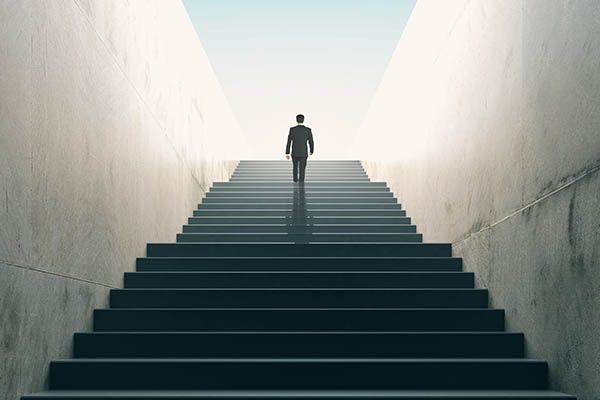
I jokingly say, but seriously say that when a toddler is learning how to walk, they tend to fall about seventeen times per hour. Each time they fall, the parent doesn’t go, “You call that walking? That was terrible. Learn how to walk, kid.” They pick the kid up, nurture them, and say, “It’s okay. You hit the floor, but you’re going to get it. Go ahead and try it.” Even from that young age, that psychological safety that is presented allows us to then take the risk and move towards healing and experiencing hope.
Dillon, I want to make sure that we point everyone to your latest book. It’s called Hope Not Nope. Everyone can find that online. Amazon or your other favorite online book retailer. It’s a great book that Dillon wrote on this concept that we spoke about in this episode. Dillon, thanks for joining me here. Let people know how they can learn more about you and follow your work.
Thanks for having me on, Joe. It’s always great to connect with you and have these conversations. My website is www.HopeNotNope.org. Instagram is @HopeNotNope. Feel free to DM us and chat with us there. As Joe said, the book is online. It’s on Amazon and Barnes & Noble. There’s an Audiobook, physical copy, and Kindle available. Whatever one you like to read, it’s available for you there.
Everyone, hop on over to HopeNotNope.org to check out the book. If you are on Instagram, you can reach out to me or Dillon. You can find us on Instagram. We do lots of activities there. I want to thank everyone for joining us to talk about the importance of hope, healing, and overcoming chronic pain. Make sure to share this episode with your friends and family on Facebook, LinkedIn, Twitter, and Instagram, wherever anyone is talking about chronic pain and the hope to overcome it. See you next episode.
Important Links
- Prehab Podcast
- Hope Not Nope: Using Hope For Healing and Reclaiming Identity as a Lifelong Athlete in a Sick Healthcare System
- @HopeNotNope – Instagram
- Instagram – Dr. Joe Tatta
About Dillon Caswell
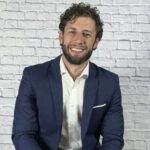 Dr. Dillon Caswell is a sought-out enthusiastic clinical Doctor of Physical Therapy with expertise and a Board Speciality Certification in Sports. He has spent more than 10 years in higher-level education both as a student and adjunct professor at SUNY Upstate Medical University.
Dr. Dillon Caswell is a sought-out enthusiastic clinical Doctor of Physical Therapy with expertise and a Board Speciality Certification in Sports. He has spent more than 10 years in higher-level education both as a student and adjunct professor at SUNY Upstate Medical University.
He desires to empower and educate the next generation by cutting through the biased lies surrounding the human experience by constantly seeking and delivering the truth in science and healing. This mission has fueled him to author Hope Not Nope: Reclaiming Identity as a Lifelong Athlete in a Sick Healthcare System and to host one of the top alternative health podcasts in the world: The Prehab Podcast.
Dr. Caswell embodies servant-based leadership, bringing people that have been shamed with “nope” to the truth of hope, in a practice he founded and owns: Action Potential Performance Physical Therapy (AP3T), PLLC in Syracuse, NY.
